Skip to main content
Elon Musk and the IMAGINATION FAILURE OF OUR IN SPACE - PART 2
- Musk’s Starman followed in the footsteps of earlier test-dummy men: there was Ivan Ivanovich, a life-size mannequin who flew in a Vostok capsule a month before Yuri Gagarin became the first person to venture into space, in 1961; and SuitSat-1, a spacesuit repurposed, in 2006, as a satellite, and nicknamed Mr. Smith; and Mannequin Skywalker, who was sent up, in 2017, in a test of the New Shepard rocket designed by Jeff Bezos’s space company, Blue Origin. The few female avatars who’ve made it into space have done so with breasts exposed. One of the experimental V-2 rockets created for Hitler, in 1942, by S.S. Major Wernher von Braun—who, after the war, was poached by America to jump-start the space program—bore a logo from a popular German science-fiction film, “Frau im Mond”: a naked woman in high-heeled boots, sitting on a crescent moon, straddling a rocket. (When von Braun was asked, in the sixties, about the possibility of female astronauts, he made a sly joke about them being “recreational equipment.”) In 2016, when Richard Branson unveiled Virgin Galactic’s second SpaceShipTwo, its side displayed an eerily similar image: Galactic Girl, a space-age incarnation of the big-chested woman who graces some of Branson’s Virgin Atlantic airplanes. Blond and lily white, Galactic Girl is also supple: she seems to be doing a backbend in a strapless spacesuit, showcasing how perky her bosom is in zero gravity. (She was allegedly designed to resemble Branson’s mother, Evette, when she was young.)
- Astronaut culture has always thrived on exclusivity. In the earliest years of the space age, during the Cold War, the high status of astronauts was linked to who was barred from the applicant pool—it would have dented the prestige of spaceflight, for both Soviets and Americans, if it were so simple that a woman could do it. “The exclusion of women and racial minorities from the pioneering astronauts corps of the 1950s and 1960s was a deliberate gesture,” De Witt Douglas Kilgore argues in his book Astrofuturism: lScience, Race, and Visions of Utopia in Space,” from 2003. Musk and his fellow-“astropreneurs” talk about democratizing space travel; Branson has said that his company’s goal is to make space accessible, because “by doing that we can truly bring positive change to life on Earth.” In this view, the fastest way to get more women into space is by backing space-tourism startups, trusting that they will open the cosmos to the masses (once the super-wealthy have had their fun). But it’s not enough to promise women that one day they, too, could become passengers to space. As Ryan Jenkins, a Cal Poly ethicist who writes about emerging technologies, told me, “democratization is not only about access but about input. Who is able to guide and shape these activities?”
- In “Space Barons: Elon Musk, Jeff Bezos, and the Quest to Colonize the. Cosmos,” Christian Davenport tells the backstories of the billionaires who are vying for control of the emerging NewSpace industry. In addition to Musk and Bezos, Davenport writes about Branson and Paul Allen, the co-founder of Microsoft and an early investor in new spaceflight technologies. The members of the quartet are so similar in type that their biographies, as Davenport relates them, start to blur into one. As boys, they mostly read the same science fiction. (Musk has said that his favorite Robert A. Heinlein novel is “The Moon Is a Harsh Mistress,” which is set on a lunar colony where young girls marry men and women are either homemakers or work at beauty shops or brothels.) The space barons were all outsiders as young men; they’re all obsessed with rockets; they all want, more than anything, to win. Their space ventures are supposedly driven by a common goal of elevating or saving humankind, but they don’t always treat others humanely.
- In his acknowledgments, Davenport admits that it’s “awkward writing a book about someone who could have you fired” (Bezos owns the Washington Post, where Davenport works) but claims that Bezos gets “the same treatment in these pages” as the other men. I would say that’s true, but mostly because Davenport treats all of the barons as heroic saviors of the crumbling dreams of the space age, boldly taking charge of our destiny. “Instead of hoping Kennedy would rise from the grave and give them the space program they wanted,” Davenport writes, “maybe they were, themselves, the people they’d been waiting for.” Seemingly dazzled by these billionaires, and fascinated by their cutthroat competition to dominate private space services and travel, Davenport situates himself firmly within the booster tradition established by Wolfe and Norman Mailer, whose “Of a Fire on the Moon,” which was drawn from his reporting for Life on the Apollo space launch, was published in 1971. Unsurprisingly, phallic metaphors, many of them deployed by the barons themselves, abound in “Space Barons.” A Musk fan posts an image, on Twitter, of Blue Origin’s rocket beside SpaceX’s, in order “to illustrate,” Davenport notes, “how the endowed Falcon 9 made the New Shepard look prepubescent by comparison.” When Blue Origin contests SpaceX’s purchase of the historic launch pad 39A, at the Kennedy Space Center, Musk calls it “launch site envy.” Watching SpaceShipOne soar in an early test, Davenport reports that Branson turned to Allen and said, “Paul, isn’t this better than the best sex you ever had?”

Comments
Post a Comment